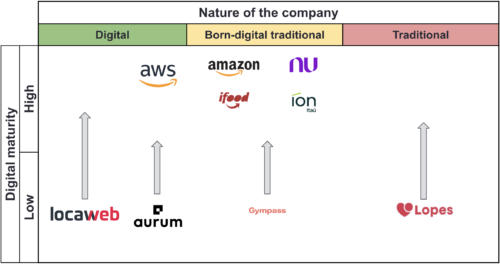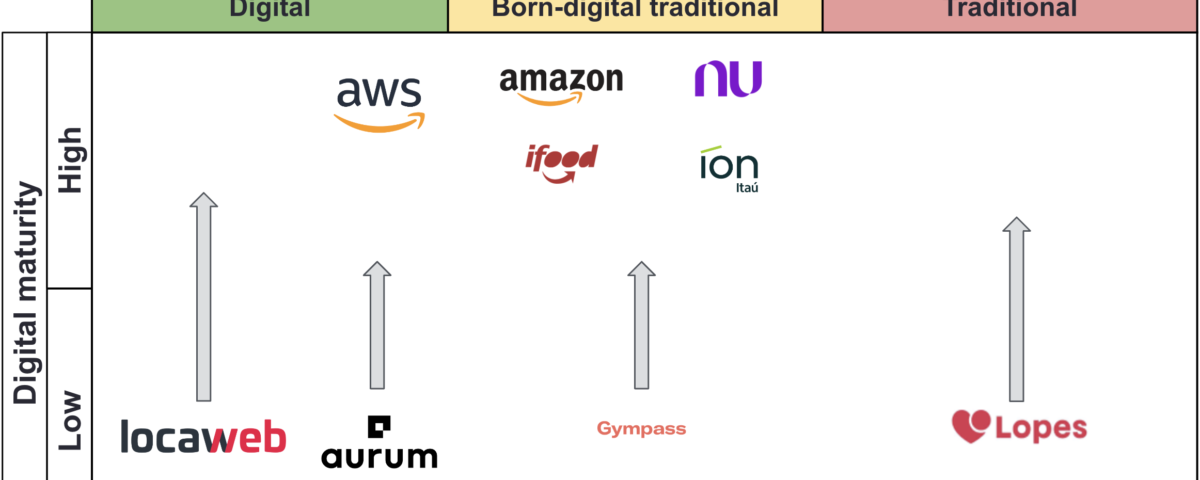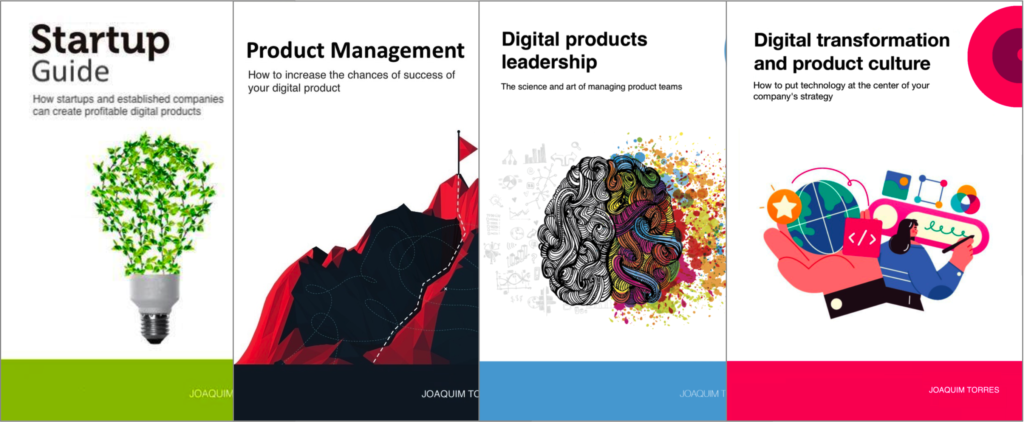
Types of company
26 de February, 2024
Business models
12 de March, 2024This article is another excerpt from my newest book “Digital transformation and product culture: How to put technology at the center of your company’s strategy“, which I will also make available here on the blog. So far, I have already published here:
- About the book
- Part 1: Concepts
- Chapter 1: The so-called digital transformation – Project and Product
- Chapter 2: Uncertainty and digital transformation
- Chapter 3: Types of company
Let’s now dive into chapter 4, about:
Type of company vs digital maturity
When presenting this classification of company types during an in-company training, people attending the training mentioned that they were investing heavily in their digital transformation to become a digital company. However, according to this classification, they would never be digital, as it does not allow for any movement between categories.
That’s true; this classification speaks about the type of company in terms of its nature, how it was conceived, and what its primary product or service is. The only way for a company to be more digital in this classification is by creating new businesses.
For example, Amazon, a digitally born store, created AWS (Amazon Web Services), a new business to offer technology infrastructure as a product. This makes AWS a digital company, while Amazon remains a traditionally born digital company. On the other hand, Amazon also builds physical stores, and that does not make it more traditional. Even though it has built physical stores, Amazon remains a traditionally born digital company.
In addition to having clarity about the type of company, there is another concept that helps understand how the company is in terms of using technology to enhance its business. It is the concept of digital maturity, which indicates how much the company has been investing in digital products to leverage its results and how much the results have actually been enhanced by these digital efforts.
The Itaú bank has matured significantly in the use of digital technologies to enhance its results. I have been a client of Itaú since they acquired the operations of BankBoston in Brazil in 2006, and I do everything I need from a bank using their digital channels, which have improved significantly over the years. In addition to this constant improvement in their digital channels, they have created two new businesses that are traditional but born digital: iti by Itaú, which is a digital bank, and íon by Itaú, which is a digital investment platform.
Another good example is Lopes Consultoria de Imóveis, a company founded in 1935 and which has been investing in its digital transformation since 2019. I worked at Lopes between 2020 and 2022 leading this digital transformation and learning a lot on this journey. During this period, we managed to go from 40% of sales coming from digital to more than 55% of total sales. We were able to build digital products to solve the problems not only of people who wanted to buy a house, but also of people who wanted to sell a house — such as the product for evaluating properties based on data science — and of brokers, who started receiving better leads, more aligned with your experience and knowledge, increasing their conversion rate, thanks to new lead allocation algorithms. So, we can say that both Itaú and Lopes are digitally mature companies.
Is digital maturity a concept that only applies to traditional companies?
As digital companies and born-digital traditional companies are already digital, we might think that discussing digital maturity only makes sense when talking about traditional companies, right?
Wrong! I will give three examples that show that digital companies, as well as traditionally born-digital companies, can indeed have low digital maturity.
Locaweb
When I joined Locaweb in 2005, the company had about 100 people, and the product development team had around 30 people, which is a good size. However, product development was done in a very old-fashioned way, using a waterfall approach based on ideas from C- level executives and sales requests, without any conversation with the customer.
I remember filling out a PRD (Product Requirement Document) with all the requirements for a new product we were planning to launch based on the ideas of C-level executives. After completing all the details, which took me 2 months to do, I handed over to engineering a document of over 25 pages, filled with details about the product.
The engineering team took 5 months to deliver the finished product. During that time, whenever I asked about the development progress, the response I received was that the development was going as planned, and they were strictly following the PRD. When it was ready, I went to test the product and discovered that an expected functionality was missing. I checked the PRD to see if I had forgotten to include that specific functionality, but no, I hadn’t forgotten; it was there. So, talking to the engineers, they reviewed the documentation, didn’t understand all the details of the functionality, and, in the rush to deliver, decided not to include the functionality.
Through this example, it becomes clear that our digital maturity at that time was quite low. We managed to evolve and increase our digital maturity over the years. This is a good example of a digital company whose product is the software or technology developed by the product development team but had low digital maturity and improved over time.
Aurum
This is the company of two good college friends. They graduated around 1990 and, at that time, created a product to assist lawyers in their day-to-day work. Like every software from the 1990s, it was an on-premise software, meant to be installed on each lawyer’s computer. Later, they released a client-server version where lawyers could exchange information through the system, and the work done by each lawyer was stored on a local server.
Around 2010, they began to realize the need to migrate to the cloud, and I helped them with one of my early consulting projects. The big dilemma they faced was: how to transition everything created over 20 years of work in the client-server version to the cloud? Surely, this would take a long time, and most likely, the client would not perceive any value and wouldn’t be willing to pay extra for this new software. Aurum would invest a lot of money to create new software that would essentially do the same as the client-server version, and there wouldn’t be a way to charge more from their clients to get a return on that investment. What to do?
They pursued two simultaneous paths, which are two excellent strategies for similar cases:
- New Segment: Building a web development from scratch was the decision Aurum made in 2010, leading to the creation of Astrea. While Aurum’s main product was a mature product focused on large law firms and legal departments of major companies, Astrea targeted small law offices and independent lawyers who didn’t need all the complexity of Themis. This allowed them to create a simple minimum viable product (MVP) to launch in a segment closely related to the one they already operated in, without requiring all the complexity of their mature product.
- Legacy Strangulation: While one team experimented with the new product for the new segment, Astrea, the mature product, Themis, had to be modernized. This was done using the legacy strangulation strategy, which involves gradually moving pieces of the product from old technology to newer technology. The prioritization of which piece to move should be mainly motivated by business and user needs. Whenever there is a need to implement something in the legacy system due to a business requirement or to solve a customer problem, it’s an excellent opportunity to implement it outside the legacy system, in a more modern system architecture. Over the years, it’s possible to substantially reduce the legacy system until it eventually ceases to exist. In Aurum’s case, this modernization process for Themis lasted almost 20 years. They started in 2005 with the web version so that lawyers could access the same data they used in the office while traveling or even at home.
It’s important to note that both strategies prioritize business and customer value as guiding principles for prioritization. Technical needs don’t guide the decisions; instead, it’s the business and customer needs. The focus is on generating business and customer value while taking the opportunity to update technology.
In building Astrea, the priority was to serve a new market segment, small law offices, and independent professionals, and, in doing so, learn about cloud-based product development technology. This led to the creation of a new revenue stream.
In the strangulation of the desktop version of Themis, the goal was always to keep pace with and anticipate customer needs, allowing them to access their data from anywhere, thus increasing engagement and retention.
Aurum is another good example of a digital company whose product is sold by the software or technology developed by the product development team but had low digital maturity and improved over time.
If you want to delve deeper into Aurum’s digital transforma- tion journey, check out this interview.
Gympass
When I joined Gympass in mid-2018, the company already had 800 employees and was present in 14 countries. However, the entire product development team, including engineers, product designers, and product managers, consisted of only 30 people—less than 4% of the company was focused on product development. The impact of this small team in relation to the size of the company was that, at that time, many of the day-to-day tasks with customers and partners had to be performed manually.
For this reason, Gympass had a huge operations team to handle all these manual tasks. The more Gympass sold, the more people were needed in the operations team. And the app was still a webview version.
The C-level executives and the board recognized the need to invest in digital to scale the company, and this team grew considerably to around 250 people who automated many manual operations tasks and delivered and evolved a fully native app.
This is an interesting example of a traditional digital-born company that sells a corporate benefit to its clients so they can offer their employees access to a network of tens of thousands of gyms and studios but had low digital maturity. This usually happens when the founders of a digital-born company that is using digital to improve a traditional business have little or no prior experience with digital products. If they don’t bring in some people with this experience to the founders’ team, there is a good chance that the digital maturity of this company will be low.
Company nature vs digital maturity matrix
When evaluating a company from the perspective of using digital technologies, we should consider two dimensions. On the X-axis, we think about the nature of the company — whether it is digital, traditional, or traditional born-digital — and on the Y-axis, we assess its digital maturity, as shown in the following image:
 Company nature versus digital maturity matrix.
Company nature versus digital maturity matrix.
How to improve digital maturity of your company?
This is an excellent question and it is the motivation I have for writing this book: to help people increase the digital maturity of
their companies.
In the next part of this book, about Principles, I will share what principles should guide a successful digital transformation, and in the following section, Tools, I will showcase some of the tools I have used throughout my career that have helped reinforce the principles and the necessary behavioral changes to ensure that the principles continue to yield results.
In addition to the principles and tools we will explore later, to further increase the chances of success in your digital transformation, I recommend:
-
Bring in individuals with digital experience, those who have experience in bringing digital products to market, that solve customer problems and achieve the expected results for the company. These individuals will help the company understand the potential of using digital products and assist in designing a strategy to fully leverage this potential.
-
Pursue education and training so that individuals without adequate experience in digital products can learn more quickly. This can include books (like this one!), courses, events, blogs, and in-company training. This topic should be central not only for those working directly in the product development team but for everyone else in the company to understand how digital can positively impact the company and its areas.
Before you get excited and dive straight into learning about the Principles that form the foundation for the success of a digital transformation, I ask that you hold off a bit on the excitement and carefully read the next chapter on Business Models. This is an essential concept that will help us understand where the use of digital technologies can generate more value and results.
Recommendation
Before embarking on your digital transformation journey, it’s important to understand that the type of your company, and its nature, do not change. Digital transformation will help increase digital maturity, but it won’t change the type of your company. You can only change the type of the company by creating new businesses, as Itaú did with iti and íon, and Amazon did with AWS. However, note that they did this only after reaching a high level of digital maturity. Therefore, the main focus should be on increasing the digital maturity of your company.
Summing up
-
There are 3 types of companies: digital companies, traditional companies, and traditional companies born digital. This is the nature of the company and cannot be changed.
-
On the other hand, we can also analyze a company based on its digital maturity, which is its ability to use digital products to deliver a better experience to its customers and improve the company’s results.
-
Typically, traditional companies have low digital maturity, but they can evolve over time. However, even traditional companies born digital and digital companies can also have low digital maturity, as shown by examples from Gympass, Locaweb, and Aurum.
-
To improve their digital maturity, these companies need to (1) bring in people with experience in digital product development and (2) seek education and training so that people without adequate experience in digital products can learn more quickly.
Workshops, coaching, and advisory services
I’ve been helping companies and their leaders (CPOs, heads of product, CTOs, CEOs, tech founders, and heads of digital transformation) bridge the gap between business and technology through workshops, coaching, and advisory services on product management and digital transformation.
Digital Product Management Books
Do you work with digital products? Do you want to know more about managing a digital product to increase its chances of success, solve its user’s problems, and achieve the company objectives? Check out my Digital Product Management books, where I share what I learned during my 30+ years of experience in creating and managing digital products:
- Digital transformation and product culture: How to put technology at the center of your company’s strategy
- Leading Product Development: The art and science of managing product teams
- Product Management: How to increase the chances of success of your digital product
- Startup Guide: How startups and established companies can create profitable digital products


